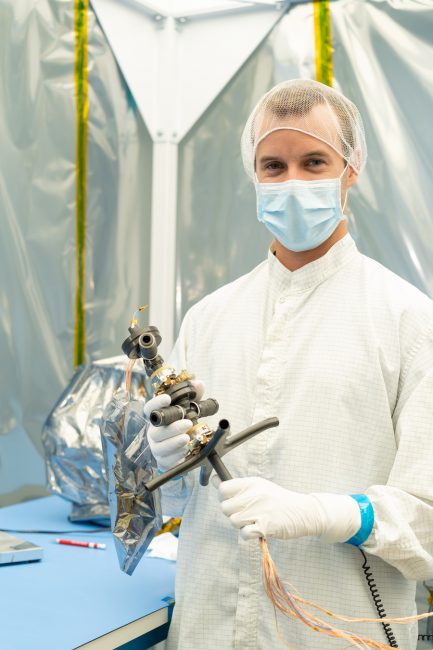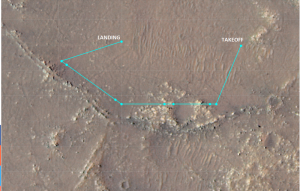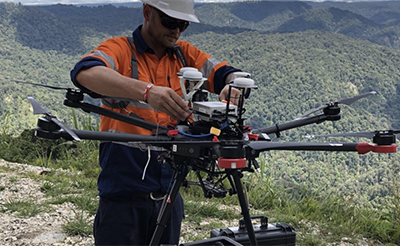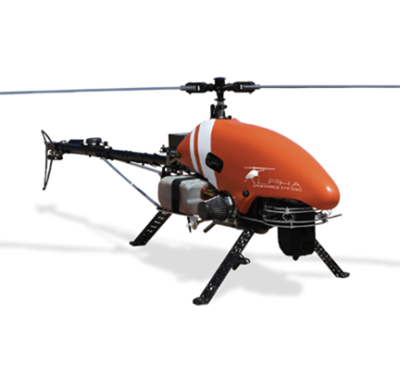
Ben Pipenberg, developing Ingenuity pre-flight. Photo courtesy of AeroVironment.
Hitting Double Digits, Mars Helicopter Ingenuity has exceeded expectations
“This flight was specifically designed to hit some high-value science targets, to demonstrate, basically, aerial imaging of science sites.” Ben Pipenberg, senior aeromechanical engineer at AeroVironment, was explaining. “That was kind of the first time we’ve really done that in a targeted way, so this was a much more complicated flight.”
Pipenberg was extolling Mars Helicopter Ingenuity’s 10th foray since it first lifted off from the Red Planet’s surface back in April. Flight 10 was something of a watershed; it saw the little vehicle Pipenberg and his team had birthed in concert with NASA/JPL and other leading-edge firms pass the mile marker on distance flown while ranging further and further afield from its mid-February arrival on Mars in the belly of the Perseverance land rover.
Pippen laughed after hearing Ingenuity’s various destinations described as “a cruise ship on Mars.” Flight 10 came on July 24th, after a hoped-for initial set of five technology trips had been extended to operational demonstrations and journeys to other “airfields.” The 10th trip initiated what might be called an investigatory phase, setting an altitude record (40 feet) and visiting 10 waypoints en route to a rock formation called “Raised Ridges.” The color photos and 3D images it collected will inform Perseverance’s up-close exploration of the outcrop, in part to seek evidence for a watery past on Mars. That’s already begun: an 11th flight, on August 5th, positioned Ingenuity as a scout to support Perseverance’s work.
“The whole team is absolutely ecstatic, as I’m sure that you can imagine.” Pipenberg said about Ingenuity’s accomplishments.

Planning groundtracks and waypoints for the 10th flight. Photo courtesy of NASA/JPL.
Onward and Upward
After years in the lab engineering rotor spin for Mars’ ultrathin atmosphere and satisfying requirements for a helicopter-within-rover-within-capsule Russian nesting doll design, Pipenberg was pleased that Ingenuity has significantly surpassed those initial projections. “The original scope ended after Flight 5; technology demonstration—we can fly on Mars. Six marked the beginning of the operational demonstration phase, and maybe the first three flights from there were kind of envelope expansion. This is really the first time that we’re doing good science work.
“That’s a huge step in the right direction. The fact that the hardware is still working and contributing to actual planetary science now, was not expected.”
Ingenuity has overcome some operational speed bumps, notably in-flight anomalies that were traced to the camera navigation system. “It’s always different when you get to reality,” Pipenberg noted. “But the way those images are handled was updated. That’s great news. We’re increasing the capabilities to show exactly how far this thing can go.”
Environmental Lessons
Pipenberg enumerated the various types of knowledge Ingenuity already has contributed.
First up were three environmental solutions.
“A big part of developing the helicopter; we don’t have or we didn’t have a whole lot of information about the weather, the atmosphere, the terrain. Nobody had ever been to Jezero Crater. We had satellite pictures; we didn’t really know what the density was going to be, what the wind was going to look like.
“We had estimates based on simulations. Now we have ground truth, and we’ve learned quite a bit about how a helicopter actually operates in that environment.”
Another environmental unknown involved Mars’ dustiness. “If you followed InSight [a 2018 Mars lander],” Pipenberg noted, “you know it’s slowly losing power because the solar arrays are covered in dust. Well, it turns out that every time we take off, we clean the dust off Ingenuity. That’s big information: we weren’t sure if the helicopter was going to kick up dust that would interfere with the navigation cameras, or the laser altimeter. Ingenuity is self-cleaning, so totally not a problem. On the next version, we could potentially back off on some of the margin we’ve applied to the landing gear system, which increases the capabilities of those systems.
Thermal insights completed Pipenberg’s environmental triad. “We kind of have ground truth now for how much energy it actually takes to survive overnight, based on the insulation that we have, the solar power available. There’s a lot of really good information that we’re pulling out of these flights.”
Collaboration Lessons
External and internal teamwork also came to the fore.
“I think that was an extremely good experience,” he said about working with partners at JPL and NASA. “And I believe JPL would say the same thing.
“Internally, we really had to have all of the subject matter experts weighing in. On a lot of aspects, from materials to thermal to aerodynamics, power systems, structural analysis, there’s a huge amount that goes into optimizing a system like this. And so it was very, very cross-disciplinary.
“It’s exactly the same with JPL; we were obviously working very closely with them. From my perspective as engineering lead for the airframe, it was very similar pulling in subject matter experts from AeroVironment versus pulling in subject matter experts for JPL. We’d have everybody in the room, and JPL obviously has phenomenal resources that AeroVironment does not have in terms of space expertise. So yeah, really, really good partnership.”
Personal Lessons
While Ingenuity keeps contributing, the majority of its AeroVironment task force, at least the design team and the fabrication team, has also been assigned other work, and Pipenberg said JPL’s operations team has scaled back as well. He cited a positive reason: “It takes less time now we know what we’re doing. It’s a much more smooth process to plan and execute flights. “
Pipenberg chuckled when asked what he and his close colleagues had learned personally from Ingenuity’s missions to date.
“We spend five years agonizing everything that could possibly go wrong. It’s kind of a different mentality, building a spacecraft to building terrestrial aircraft, especially the way that we at AeroVironment operate. Typically, when we’re trying to innovate a new solution to something, we ask ‘is this possible, could this potentially work?’ Then we go test it, and we try it, evaluate it.
“With spacecraft, the stakes are so high, and you just can’t fix anything that goes wrong. And so the mentality is we assume that everything that can go wrong will go wrong. We designed to make sure that those can’t interfere with the solution.
“It’s really interesting to kind of see all of these things we agonized over turned out not to be issues.”
What’s Next?
“Flying faster and farther is certainly a goal,” Pipenberg offered. “[But] we’re starting to get close to some of the limits. Our flight time now is almost twice what it was designed for the maximum flight. The altitude is actually higher than what it was designed to fly at any speed level.”
Nevertheless, “a lot of ideas are floating around. I think a big one is going to be attempting to image sites that are being identified by the science community in real time that the rover can’t get to. Flight 10 was already the first pass of that.”
At the same time, AeroVironment is identifying new challenges to meet.
“We’re putting in some of our own research and development funds looking at kind of the broad technologies that are enabling for next generation aircraft, additional mobility systems, instrument packages, that kind of thing, as well as configurations and missions,” Pipenberg said. “We’ll have some conference papers coming out, I think in the next year, talking about that.
“NASA Ames is working on a larger science helicopter. And I guess we’re a collaborator with JPL.
That would be for Mars as well. It’s a much larger vehicle, basically a standalone science platform. It wouldn’t be traveling with a rover. So that’s very exciting. NASA Ames has been putting out a handful of papers on that.”
Still, the AeroVironment team isn’t ready to see Ingenuity parked permanently.
“We really didn’t expect to have the opportunity to continue flying,” Pipenberg concluded. “We really thought Flight 5 was going to be it. This is all gravy to us.”






